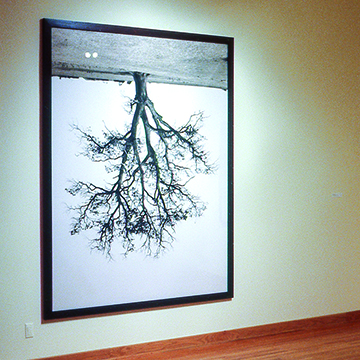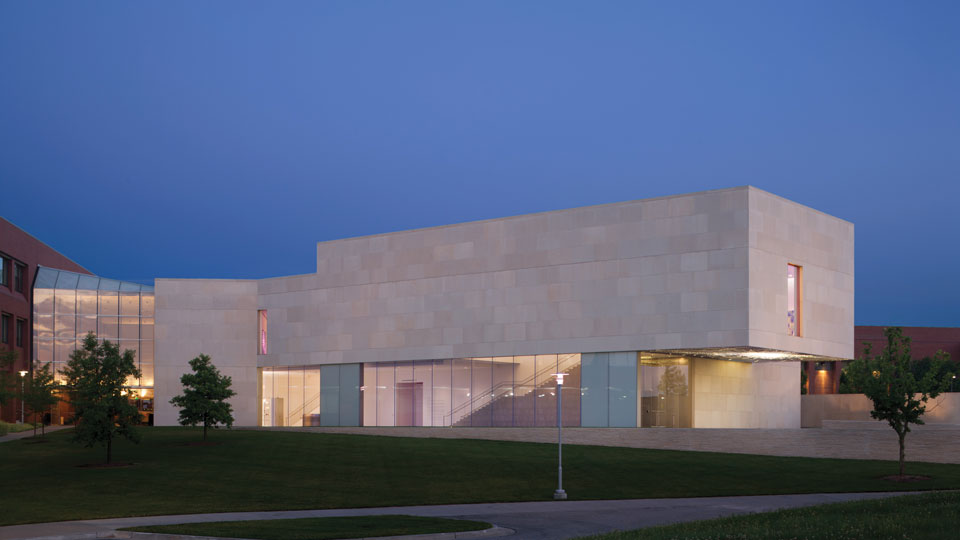Rodney Graham
Rodney Graham’s oak trees, which precariously descend from the top of his large-scale photographs, are not merely hung upside down, but rather carry a plentitude of meaning with them. From the beginnings of landscape photography to environmental concerns and man’s symbolic position within modern society, Graham positions his trees in a way that communicates many concerns. His work will be on display in addition to a selection of recently acquired works from the permanent collection. These artists comment on issues ranging from ageing to Holocaust survivors and environmental concerns.
Graham is best known for his conceptual art pieces and limited edition books. His current exhibition of inverted tree photographs stands as an ode to Graham’s interest in the camera obscura, a camera that preceded conventional photography by several hundred years. A camera obscura inverts an image, this providing the inspiration for Graham’s work even though his photographs were taken with a conventional view camera and sharp lens.
The upside-down delivery is also rooted in Graham’s interest in symbolism. “I created an inverted tree because I wanted to talk about man’s skewed experience of nature inside a functional architectural space in the middle of a landscape,” he said in a 1992 interview for Art and Antiques magazine. Fellow artist Jeff Wall has also noted Graham’s interest in trees as being linked to the massive deforestation of British Columbia and the tree’s romantic symbol as unity with the natural world, as well as an emblem of the nobility of man within nature.
Born in 1949 in Masqui, British Columbia, Rodney Graham studied art history at the University of British Columbia from 1968 to 1971 and at Simon Fraser University in Vancouver from 1978 to 1979. Beginning with a series of solo shows in the late 1980s, he has exhibited widely in North America and Europe, including in Documenta IX, 1992, and in the Biennale of Venice, 1993 where he represented Canada. Graham lives and works in Vancouver.
Recent Photography Acquisitions includes works by seven artists:
Robert Adams was born in 1937 in New Jersey grew up in the suburbs of Denver, CO. He moved to southern California in 1956 to attend the University of Redlands. He majored in English literature and went on to earn a PhD at the University of Southern California in 1965.
New York artist Zeke Berman was born in 1951 and received a BFA in sculpture from the Philadelphia College of Art in 1973.
Originally from Sioux City, Iowa, Kansas City artist Deanna Dikeman was born in 1954 and holds degrees in biology (1976) and management (1979) from Purdue University, West Lafayette, Indiana.
Emmet Gowin was born in 1941 in Danville, Virginia. He graduated with a BFA in graphic design from Virginia Commonwealth University, Richmond, in 1965 and received an MFA in 1967 from the Rhode Island School of Design, Providence.
Kenneth Josephson was born in 1932 in Detroit, Michigan. He graduated in 1957 with a BFA in photography from Rochester Institute of Technology, and earned an MS degree in 1960 in photography from the Illinois Institute of Design.
Nicholas Nixon was born in 1947 in Detroit, Michigan, and received a BA in English from the University of Michigan in 1969 and an MFA from the University of New Mexico in 1974.
Ruth Thorne-Thompsen was born in 1943 in New York City. In 1963 she studied dance at Columbia College, and then she graduated in 1970 with a BFA in painting from Southern Illinois University, Carbondale. In 1973 she received a BFA in photography from Columbia College, Chicago, and she earned an MFA in photography in 1976 at the School of the Art Institute of Chicago.
Jeffrey Wolin was born in 1951 in New York and graduated with a BA in 1972 from Kenyon College, Gambier, Ohio. In 1977 he earned an MFA from the Rochester Institute of Technology, Rochester, New York. Wolin is a professor of photography and director of the School of Fine Arts at Indiana University.





